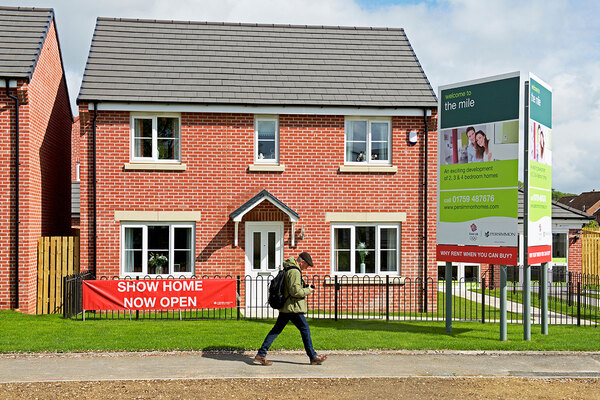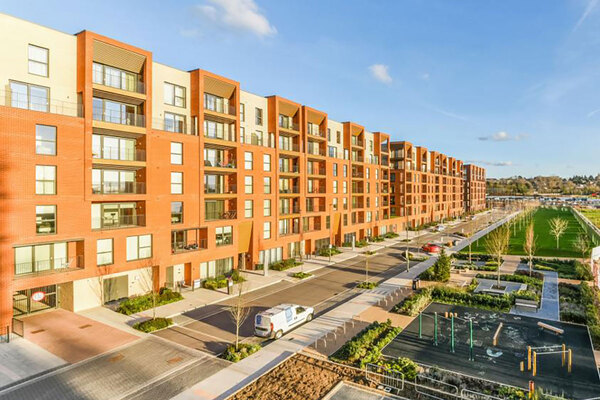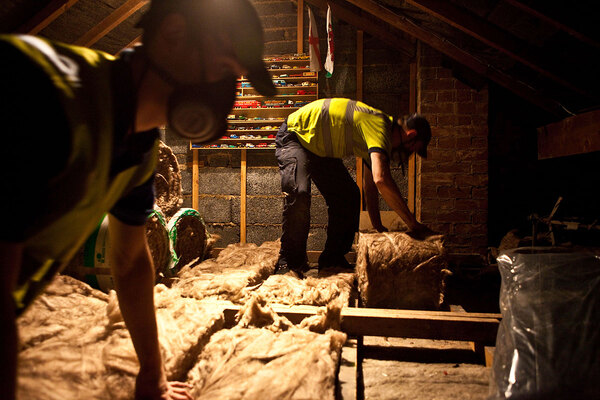Development in Scotland: what’s the dilemma?
The Scottish government has sliced a chunk from its grant programme to build affordable housing. James Riding looks into how the sector might respond. Illustration by Anna Wray
Even before the general election was called, 2024 was already a year of the highest political drama in Scotland. The SNP-Green coalition broke up and a new first minister, John Swinney, took the helm of a minority SNP government. Then Scottish Labour bounced the SNP into declaring a nationwide housing emergency – a rather humiliating admission, given that it had governed since 2007.
One decision may prove to have the most lasting consequences: the Scottish government’s choice to cut its Affordable Housing Supply Programme (AHSP). The grant programme for new social housing is down 26% for 2024-25 – £196m less than what was handed out the year before. Development is already faltering. Housing associations started just 2,073 new homes in 2023, a 22% decrease on 2022 and the lowest number since 1988.
In one of his last acts before resigning as first minister, Humza Yousaf tried to mitigate the damage. He announced £80m over two years to help councils buy up empty homes for social housing. Sector bodies welcomed the boost, but were quick to point out that it will not build a single new social home.
The sector is lobbying the Scottish government to undo the AHSP cut, but development directors have to make tough decisions in the meantime. How are housing associations and councils responding?
Tricia Hill, development director at Kingdom Housing Association in Fife, tells Inside Housing the “unexpected nature” of the cut has been difficult for a landlord with big building goals.
“We were ready to go with an ambition of 3,000 homes over the next five years,” she says. That is not going to happen now. As she baldly puts it: “We will deliver fewer homes than anticipated.”
Kingdom hopes funding will return in a couple of years, but there are no guarantees – the association is “planning for the worst”, Ms Hill says.
Each year, Kingdom sets out its development projects and the amount of grant it expects to spend over 12 months. Ms Hill says it is choosing “what to potentially slow down” now, so spending is shunted back a year. “We are prioritising projects that cannot stall,” she says, such as schemes where the association owns the land or where they have a deal with a contractor ready to go.
The uncertainty also affects contractors, as Kingdom is unable to confirm if projects can go ahead. Builders could be forced to lay staff off as demand falls, meaning capacity will take time to rebuild if funding returns.
“It’s not a tap you can turn on and off,” Ms Hill adds.
When the UK government slashed grant funding in 2010, this was done by replacing grant for social rent with much lower grant for affordable rent, with the gap closed by private finance backed by higher rents. Landlords also pursued shared ownership and cross-subsidy with market sale.
The Scottish government doesn’t seem likely to repeat what Westminster did. Housing minister Paul McLennan (see box), says: “Scotland has led the UK in housing by delivering more than 128,000 affordable homes since 2007. We are investing nearly £600m in affordable housing this financial year, the majority of which will be for social rent.”
But could Scottish housing associations choose to switch paths, and build mid-market rent?
Kingdom already has “quite a lot” of mid-market rent in its pipeline, Ms Hill says, so “we probably wouldn’t want to do much more”.
As it is linked to Local Housing Allowance, mid-market rent is not financially viable for every social landlord and building it has its challenges: the tenure could be subject to rent controls as part of the Housing Bill currently going through the Scottish parliament. However, “Looking at the tenure mix is one of the mitigations. A smaller [grant] pot would arguably be better serviced by projects that draw less grant,” she says.
The problem is that the Scottish government wants 70% of new affordable homes funded by the AHSP to be for social rent. If the balance of tenures starts to tip, that goal would be at risk.
The impact of the cut will not be distributed evenly. Kelly Adams, chair of the West of Scotland Housing Association and a partner at auditor RSM, says larger housing associations are “still ploughing ahead” with their building programmes. However, those that “might have been thinking about doing development, maybe those that just dabble in it now and again or aren’t key developers, might just be put off” and “park it for another year or two”.
It is also likely that more rural parts of Scotland, such as the Highlands and Islands, will feel the brunt of the cut, as construction costs are already higher there.
Most housing associations will have committed to their pipeline for the next year at least, says Ms Adams, but they will have to factor the cut into their five-year financial plans. These must be submitted to the Scottish Housing Regulator by the end of May.
Comment from the housing minister
Housing minister Paul McLennan told us in a statement: “We remain focused on delivering 110,000 affordable homes by 2032, and to support that, we have brought forward a review to this year.
“The UK government failed to inflation-proof its capital budget, and this has resulted in nearly a 10% real-terms cut in our UK capital funding between 2023-24 and 2027-28. Likewise, our financial transactions budget – key to delivering affordable housing – has been cut by 62%.”
Her own housing association has reduced its 2021-26 development target from 700 to 520 homes. However, she attributes this more to rising development costs, competing priorities and trying to keep rents as low
as possible than the grant cut.
A general climate of uncertainty has affected development in Scotland over the past few months. “You’ve got councils like Edinburgh which have already used up the [affordable housing] budget for this year,” says Ms Adams. Edinburgh completed 238 homes in 2022-23, and as of last autumn had ambitions to build 4,133 in the next five years.
In May, City of Edinburgh Council officers warned that the local authority was “unlikely to be able to approve any new grant-funded affordable homes this year, and there is uncertainty about potential commitments next year”.
Jane Meagher, housing convenor of the City of Edinburgh Council, tells Inside Housing the “shocking” cut to the AHSP budget is “a real hammer blow”.
“We are looking at as many alternatives as we can,” she says. Joint ventures and different funding models could be part of that – the council promised to consider these options in a housing emergency action plan, “but that’s going to take time to work through and produce results”.
Ms Meagher says the cost of building an affordable home in Edinburgh has almost doubled, from £157,000 in 2020 to around £300,000. Where grant once covered 46% of the cost of each new home, it now covers only 30%. “In the past, the grant-funded element would have helped us, at least in part, to be able to build,” she says. “But that bit of carpet has been whipped away from under our feet.”
New social rent homes are still a priority for the council, even with the cut in grant funding. “For every social rented home that’s advertised in the city, we get around about 200 bids,” she says. Employers are struggling to find care, hospitality and retail workers, because they cannot find an affordable place to live.
Private investment
Last year, Edinburgh was able use £10m that had been allocated to other councils but went unspent.
Now, Ms Meagher says: “It strikes me as highly unlikely, given that the AHSP budget has been cut by £200m, that other authorities are going to have any spare pennies in the coffer that can come our way. Any civilised country should be able to provide the basic needs of its residents, and housing is one. If we can’t achieve that, then we’re failing. We’re absolutely failing.”
Even before the cut, housing associations were scaling back their building programmes, or putting them on hold. Leith-based Harbour Homes halted new development in October 2023, citing rising costs and procurement issues.
In 2023, the Scottish Housing Regulator analysed landlords’ five-year financial plans. It found that the total number of new homes forecast for development was just over 26,000 – 17% down on the 30,600 projected in their 2022 plans.
Glasgow City Council is getting £78.7m in AHSP grant in 2024-25. This is a reduction of 24% (£25.3m) compared with the resource planning assumption the Scottish government previously announced for the city.
A Glasgow City Council spokesperson says there is an opportunity for this budget to be increased, subject to the availability of funding from the AHSP.
26%
Decline in the Affordable Housing Supply Programme (AHSP) for 2023-24 (£196m less than in 2023-24)
70%
Percentage of homes funded by the AHSP that the Scottish government wants to be for social rent
“Clearly, given the housing need in the city and the number of major housing-led regeneration projects in Glasgow, we are keen to secure the funding needed to deliver a significant scaling-up of delivery of a pipeline of new homes,” they say.
“As outlined in Glasgow’s strategic housing investment plan [from 2024-25 to 2028-29], there is the potential to build 7,568 new affordable homes in the city, subject to funding.”
The council also confirmed there would be no switch in policy from social rent to mid-market rent.
Last year, it made a commitment in the city’s local housing strategy that 80% of new build approvals in the AHSP would be for social rent.
Susie Fitton, policy manager at the Scottish Federation of Housing Associations (SFHA), notes that there was an attempt to limit the impact of the AHSP cut on development by weighting it towards the “financial transaction” side of the budget.
These are loans and equity investments to support housing delivery, rather than direct grant funding. Year on year, the new savings of £196m are split between a £74.7m reduction in capital grant and a £121.4m reduction in financial transactions.
She says: “The context in which that budget cut lands is one of really significant uncertainty and competing priorities for housing associations.” These include a range of regulatory requirements that are coming down the track, “particularly in relation to energy efficiency and responding to net zero”.
Housing associations anticipate significant decarbonisation costs. The government had said all new build homes from 2025 would need to meet an exacting Scottish equivalent of the Passivhaus standard – although, with the Greens now out of government, the future of the latter policy is unclear. Braced for these challenges, housing associations “are reconsidering, reducing or pausing development”, she says.
Ms Fitton is alert to the risk of switching tenures. “We need to protect the funding model; public investment in social housing is what keeps rents affordable. We’re very keen that we don’t sleepwalk into a situation where we’re building homes that are not social homes.”
She says the SFHA receives “lots of reassurances from ministers” that the commitment to social housing is still paramount. “We’re told that the desire, for example, to increase the amount of private investment in the housing system… should be additionality. So it’s in no way deemed to be a replacement for public investment in affordable housing.”
However, she says: “Our concern is that there seems to be a mismatch between high-level intentions and policy.”
Sally Thomas, chief executive of the SFHA, says the cut to the AHSP “will have a devastating impact” on delivering new affordable rented homes. “We know that government is keen to attract more private investment but, until we see any evidence, we remain to be convinced that this is a solution. Social homes need government investment if we’re not to burden housing associations with debt which will force up rents.”
Recent longform articles by James Riding
Dagenham fire: what happened and what we know about the building
A fire at a block of flats in Dagenham, east London, on Monday has sparked fresh debate about the slow progress of cladding remediation in the UK. James Riding runs through what we know so far
Peter Denton discusses the Homes England review and Section 106 jitters
Homes England’s chief executive tells James Riding that a new government review is a “call to arms” for the agency to take a more hands-on role in development
The man who runs Homes England’s Affordable Homes Programme
Shahi Islam speaks to James Riding about his new role as director of Homes England’s Affordable Homes Programme and his desire to be “more front-facing” in the sector
Sign up for our Scotland newsletter
Already have an account? Click here to manage your newsletters












